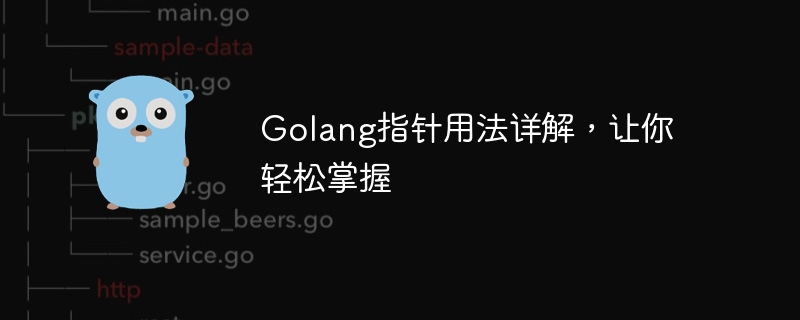Home >Backend Development >Golang >Detailed explanation of how to use Golang pointers easily
Detailed explanation of how to use Golang pointers easily
- 王林Original
- 2024-01-24 08:58:06901browse

Detailed explanation of Golang pointer usage, allowing you to master it easily, specific code examples are required
Introduction:
Golang is a concise and efficient programming language that supports pointers usage of. A pointer is a variable that stores the memory address of a variable and can be used to access and modify the value of the variable. This article will introduce the use of pointers in Golang in detail, and let readers easily master it through specific code examples.
1. Definition and initialization of pointers
In Golang, you can use the special symbol "&" to obtain the address of a variable. When defining a pointer type variable, you need to use "*" to represent it. The following is a sample code for the definition and initialization of pointers:
package main
import "fmt"
func main() {
var a int = 10
var ptr *int // 定义一个int类型的指针变量
ptr = &a // 将a的地址赋值给ptr
fmt.Println("a的值是:", a)
fmt.Println("a的地址是:", &a)
fmt.Println("ptr指向的值是:", *ptr)
fmt.Println("ptr存储的地址是:", ptr)
}In the above code, we define an integer variable a and declare a pointer variable ptr pointing to an integer. Then assign the address of a to ptr, and you can access the value of a through "*ptr", that is, fmt.Println("The value pointed by ptr is: ", *ptr).
2. Transfer of pointers
When passing pointers between functions, you can modify the variables pointed to by the pointers. When a pointer is passed to a function as a parameter, the function can operate on the original variable through the pointer. The following is a sample code for passing pointers:
package main
import "fmt"
func changeValue(ptr *int) {
*ptr = 20 // 修改ptr指向的值
}
func main() {
var a int = 10
var ptr *int = &a
fmt.Println("函数调用前a的值是:", a)
changeValue(ptr)
fmt.Println("函数调用后a的值是:", a)
}In the above code, we define a function changeValue that accepts a pointer to an integer as a parameter. In the function, the value of the variable is modified through the pointer. In the main function, we pass the address of a to the changeValue function. By changing the value pointed by the pointer, we finally achieve the purpose of modifying the original variable.
3. Pointer arrays and pointers to pointers
Golang also supports pointer arrays and pointers to pointers. Array of pointers is an array that stores pointers, while pointer-to-pointer is a pointer to a pointer variable. The following is a sample code for an array of pointers and a pointer to a pointer:
package main
import "fmt"
func main() {
var a int = 10
var b int = 20
var arr [2]*int // 定义一个存储指针的数组
arr[0] = &a
arr[1] = &b
var pptr **int // 定义一个指向指针的指针
pptr = &arr[0]
fmt.Println("a的值是:", a)
fmt.Println("b的值是:", b)
fmt.Println("arr[0]指向的值是:", *arr[0])
fmt.Println("arr[1]指向的值是:", *arr[1])
fmt.Println("pptr指向的值是:", **pptr)
}In the above code, we define two integer variables a and b, and a pointer array arr, which separates the addresses of a and b respectively. Stored into the elements of the array. At the same time, we define a pointer pptr that points to a pointer, and assign the address of arr[0] to pptr. The value of a can be accessed through "arr[0]" and "pptr".
Conclusion:
This article introduces the use of pointers in Golang in detail, and uses specific code examples to allow readers to better understand and master it. Pointers are a very important part of the Golang language, which can help us implement more efficient programs. I hope that through studying this article, readers can fully understand and use pointers and improve their abilities in Golang development.
The above is the detailed content of Detailed explanation of how to use Golang pointers easily. For more information, please follow other related articles on the PHP Chinese website!

